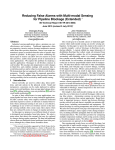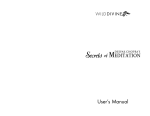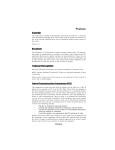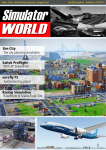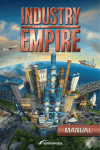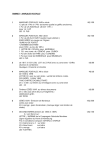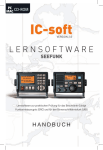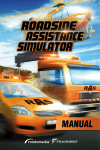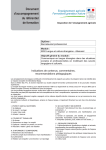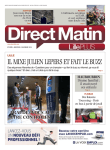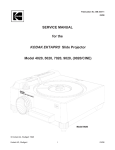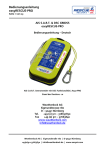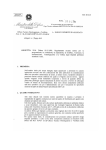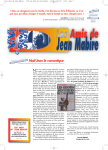Download View the manual
Transcript
Epilepsy warning Some individuals may experience epileptic seizures or a loss of consciousness when viewing certain visual stimuli, for example flashing lights or patterns. These individuals are at risk of experiencing seizures while watching television or playing videogames. Even those without any previous related health issues or signs of epilepsy can be affected by this. If any related symptoms occur, STOP PLAYING IMMEDIATELY AND SEEK MEDICAL ADVICE. Parents and supervisors should keep children within sight and ask them if they have ever experienced one or more of the above symptoms. Children and adolescents have a higher risk of experiencing symptoms of these kinds than adults when playing videogames. The following symptoms are characteristic of photosensitive seizures: blurred vision, eye or facial twitching, trembling arms or legs, disorientation, confusion or momentary loss of consciousness. During a photosensitive seizure, a loss of consciousness or convulsions may cause serious accidents, as these symptoms are often accompanied by falling. If you notice any of the above symptoms, stop playing immediately. It is highly recommended that parents observe their children while playing videogames, as children and adolescents are often more sensitive to photosensitive seizures than adults. Handbook for lifesavers 02 Besuche auch unsere offizielle Homepage www.schiff-simulator-die-seenotretter.de 03 CONTENTS 1 System Requirements 4 2 Welcome to Maritime Search and Rescue! 4 3 Installation and Start 5 3.1 Further Requirements and Help 5 3.2 Installation 5 3.3 Starting the Game 5 3.4 Uninstallation 6 3.5 Options6 4 The Main Menu 4.1 Start Game 4.2 Sea Book 4.3 Options 4.4 Credits 4.5 Quit 5 In Game or on the High Seas 5.1 Controlling the Ships 5.2 Controlling the Fire Monitor 5.3 Controlling the Daughter Boat 5.4 First-Person Controls 6 7 8 8 8 8 9 9 10 10 11 6 The Interface 6.1 The Radio 6.2 The Log Book 6.3 The Hold Course Button 6.4 The Overview Map (Mini-Map) 6.5 The Rudder 6.6 The Depth Gauge 6.7 Steering Wheel and Levers 6.8 The Menu 6.9 The Camera 6.10 The Status Bar 12 12 12 12 12 13 13 13 13 13 13 7 The Maritime Search and Rescue Team 14 8 The Rescue Cruisers 8.1 HERMANN MARWEDE 8.2 HARRO KOEBKE 16 16 17 9 Tips and Tricks 18 10Support 18 11Credits 19 1 SYSTEM REQUIREMENTS Minimum System Requirements • AMD Athlon 64 X2, Intel Core2Duo or comparable dual-core processor (min. 2.4 GHz) • Windows Vista/7/8 • 4 GB RAM • DVD disc drive • DirectX 9.0c compatible graphics card with Shader 3.0 support (min. 1 GB VRAM) • AMD CrossFireX is not supported, AMD Radeon HD3870/ NVIDIA GeForce 8800GT or better • keyboard and mouse with scroll wheel 2 WELCOME TO MARITIME SEARCH AND RESCUE! Recommended System Requirements • AMD Athlon 64 X2, Intel Core2Duo or comparable dual-core processor (min. 2.6 GHz) • Windows Vista/7/8 • 8 GB RAM • DVD disc drive • DirectX 9.0c compatible graphics card with Shader 3.0 support (min. 1,5 GB VRAM) • AMD CrossFireX is not supported, AMD Radeon HD3870/ NVIDIA GeForce 8800GT or better • keyboard and mouse with scroll wheel w w w . s h i p - s i m u l a t o r - m a r i t i m e - s a r . c o m 3 INSTALLATION AND START NOTICE: The product is subject to your acceptance of the terms and conditions of Steam subscriptions (“Steam Subscriber Agreement, SSA”). You must activate this product via the Internet by registering for a Steam account and accepting the SSA. 3.1 FURTHER REQUIREMENTS AND HELP The installation requires a one-time Internet connection for authentication, as well as the Steam client (included with delivery of the game). 3.2 INSTALLATION Please ensure that your computer is connected to the Internet before you start the Ship Simulator: Maritime Search and Rescue installation process. Insert the Ship Simulator: Maritime Search and Rescue disc into your computer‘s disc drive. During the installation process, a one-time online check will be carried out to verify the disc, and an activation file will be downloaded which will request a product code. You will find the code on the back of this manual. You set sail as others return to dry land. On the high seas: face the sheer force of the elements! And you’re steering them – the most powerful rescue vessels of the Maritime Search and Rescue Service in search of shipwrecked seafarers. As a sea rescuer, you put your life on the line – to save the lives of others! 04 Handbook for lifesavers 05 After a few seconds, a window will appear on the screen. Follow the instructions to install the game and select the directory where you would like to install the game. If the program does not start automatically, double-click My Computer on your Windows desktop. Then double-click the disc drive icon followed by the installation file icon “setup.exe” in the next window. 3.3 STARTING THE GAME 1)First click Start in the Windows taskbar, usually found at the bottom of the screen, and then Programs / or enter the name of the game into the search bar. 2)Use the mouse to select the program group <Ship Simulator: Maritime Search and Rescue> and then click <Ship Simulator: Maritime Search and Rescue>. You can also start the game using the desktop icon. 3.4 UNINSTALLATION Select “Start/Control Panel/Programs and Features” and then choose the entry <Ship Simulator: Maritime Search and Rescue>. Then click the “Uninstall” button. The program, its files and game data will then all be uninstalled. 3.5 OPTIONS 4 THE MAIN MENU The Main Menu is your point of departure into the world of the sea rescuers. From here, you can start your adventure on the high seas, find out more interesting information about the sea rescuers and configure the game to both you and your PC’s needs. You can change individual settings to better suit your PC‘s configuration in the main menu under <Options>. If your PC‘s configuration meets or surpasses the recommended system requirements, you can set all of the settings to <high>. If your PC‘s configuration only meets the minimum system requirements, or if the game game stutters or objects are not displayed correctly, we recommend that you change the settings or the resolution to a lower level. We only recommend changing these setting from low to medium or high if your PC‘s configuration significantly surpasses the minimum requirements. Should you encounter any problems, activate the compatibility mode to reset the graphics settings by holding the Shift key when starting the game. w w w . s h i p - s i m u l a t o r - m a r i t i m e - s a r . c o m 06 Handbook for lifesavers 07 4.1 START GAME North Sea Select “North Sea” from the menu to view the available missions on board the HERMANN MARWEDE. Then select one of the missions and assignments. You’ll see a short description of the situation and can start the assignment by clicking “Start Game”. You can return to the previous menu with the “Back” button. Baltic Sea Select “Baltic Sea” from the menu to view the available missions on board the HARRO KOEBKE. Then select one of the missions and assignments. You’ll see a short description of the situation and can start the assignment by clicking “Start Game”. You can return to the previous menu with the “Back” button. Tutorial and Introduction to the Game You set sail from here! We recommend you start with the tutorial, where you’ll be acquainted with the basic game mechanics. Once you feel ready to fulfill the duties of a bona fide sea rescuers, you can choose whether you want to sign up for the HARRO KOEBKE or the HERMANN MARWEDE. Free Cruise Modus Once you’ve completed all of the missions in the North Sea or Baltic Sea, you unlock the “Free Cruise” mode. In this mode, you’ll have to prove yourself in random missions and various weather conditions! 4.2 SEA BOOK 4.3 OPTIONS The Sea Book links you to the website www.seenotretter.de/ emotion/ where you’ll find lots of exciting and interesting information about the Maritime Search and Rescue Service, its history and their operations! The Options menu lets you adjust the graphics and sound settings to match the performance of your PC and your needs. 4.4 CREDITS You‘ll be surprised just how many men and women have worked hard to bring you the Maritime Search and Rescue experience! 4.5 QUIT Ends the game and returns you to your desktop. Trailer, News und Bonusmaterial gibt es unter www.schiff-simulator-die-seenotretter.de w w w. s h i p - s i m u l a t o r - m a r i t i m e - s a r. c o m 5 IN GAME OR ON THE HIGH SEAS 5.1 CONTROLLING THE SHIPS General Controls W/A/S/D keys = Forwards/Right/Backwards/Left (rudder) Q/E keys = Left/Right (bow thruster) Mouse = Interact with the interface Left mouse button = Action Right mouse button = Look around (in orbiter camera/F1) 08 Handbook for lifesavers 09 Scroll wheel = Zoom C = Switch to controlling the daughter boats “VERENA” or “NOTARIUS” – where available R key = Activates the radio M key = Overview map L key = Log book F1-F9 = Camera positions F10 = Fire monitor F11 = First-person perspective F12 = Swivel camera perspective 1 = Activate course holder 2 = Log book Left Ctrl & Num. pad +/- = Operate time-lapse (faster/slower) Left Ctrl & Num. pad */÷ = Operate time-lapse (fastest/slowest) Left Ctrl & Num. pad Enter = Quit time-lapse Advanced Controls Num +, Num - = Detailed motor lever settings Numpad 1-9 = Detailed left, center and right motor lever settings, where available U, I, O = Detailed rudder settings - / . / , = Detailed bow thruster rudder settings, where available 5.2 CONTROLLING THE FIRE MONITOR 5.3 CONTROLLING THE DAUGHTER BOAT Movement W/A/S/D Tkeys = Forwards/Right/Backwards/Left (rudder) Cursortasten = gleichzeitiges Steuern des Bootes Mouse = Interact with the interface Left mouse button = Perform action Right mouse button = Look around (in orbiter camera/F1) Scroll wheel = Zoom in/out M key = Overview map L key = Log book F1-F8 keys = Camera positions F10 key = Rescue position Mouse = Aim Left mouse button = Activate/deactivate primary water cannon Right mouse button = Activate/deactivate secondary water cannon Scroll wheel = Regulate water strength w w w . s h i p - s i m u l a t o r - m a r i t i m e - s a r . c o m 10 11 5.4 FIRST-PERSON CONTROLS Movement W/A/S/D keys = Forwards/Right/Backwards/Left Tab key = Pick up rope Mouse = Look around Left mouse button = Action Right mouse button: Click = Rope Right mouse button: Hold = Interact with the interface L key = Log book 2 = Quit first-person perspective Handbook for lifesavers 6 THE INTERFACE 6.2 THE LOG BOOK 6.1 THE RADIO You’ll find information on your current mission and mission progress in the log book. If you’re ever unsure of what to do, a quick look at the log book can be helpful! The radio is possibly one of the most useful and important devices on your sea rescue cruiser. Use your radio to receive missions and to contact people in distress. If you’re ever unsure of what to do, you can always get useful information from the command center over the radio. 6.10 6.1 6.8 6.3 THE HOLD COURSE BUTTON If you ever have to travel long distances on your way to a shipwrecked seafarer, you can click this button to ensure that you stay unaffected by wind and current – your ship will hold its course until you‘re back at the wheel! 6.9 6.4 THE OVERVIEW MAP (MINI-MAP) 6.2 6.3 6.5 6.4 The mini-map shows you which direction your next mission objective is in. Follow the green arrow to it. You can also switch the mini-map to full-screen mode for a better overview. Additionally, you can zoom in and out with the “+” and “-” keys to adapt the visual field to the situation. 6.7 6.6 w w w . s h i p - s i m u l a t o r - m a r i t i m e - s a r . c o m 12 Handbook for lifesavers 13 6.5 THE RUDDER 6.9 THE CAMERA The rudder shows you how far you have turned the wheel. Here you’ll find a list of all possible camera angles. You can change the angle by clicking a camera. You can also do this by pressing the F1-F12 keys. 6.6 THE DEPTH GAUGE The depth gauge shows you the depth of the water. Pay attention to the water depth and the draft of your ship so that you don‘t run aground! 6.7 STEERING WHEEL AND LEVERS The wheel and levers are useful for you to see how far you’re steering and at what level your engines are running at! Additionally, you can set the wheel and the levers manually and very precisely using the mouse. 6.8 THE MENU In the menu, you can change the speed of the game. You can activate/deactivate the time-lapse here. Additionally, you can return to the main menu from here by clicking “Quit”. 6.10 THE STATUS BAR You will find interesting and important information about the status of your ship and the weather conditions in this bar. THE MARITIME SEARCH AND RESCUE TEAM Arndt Holgersson Arndt Holgersson is the focus and calm of the maritime rescue team. As an engineer, he spends a lot of time below deck and ensures that the sea rescue cruiser is always operational! Even under pressure and in the most difficult of situations, he always manages to find the right words and has good advice for his crew members. Piet Söhngen Piet Söhngen, foreman and aspiring sea dog, has developed a strong bond with the sea. While his friends preferred to stay in their warm and cozy homes with a pot of tea, the wind and rain drew Piet outside. The forces of nature fascinated him and he learned to love a stormy sea more than a sunny beach. Under the keen eyes of Jonne, Piet became a seasoned sea rescuer, well-versed with the dangers and perils of the open waters and risking his life for others on the high seas! w w w . s h i p - s i m u l a t o r - m a r i t i m e - s a r . c o m Jasper Strindberg Jasper Strindberg is the youngest member of the crew. As a trained paramedic, his youthful energy led him to seek adventure on the high seas – the crew can always count on Jasper! Always high spirited and inquisitive, he’s one of the people you can tell was born to serve at sea and to save lives! 14 Handbook for lifesavers 15 Freija Ihmels Freija Ihmels is your contact at MRCC Bremen. She is in constant radio contact with the crew of the rescue cruiser. When an emergency call goes in, she is the life-saving link between the sea rescuers and those in distress. She’s always up for a joke with her “boys”, but will switch back to professional calm at the drop of a hat when it comes to saving people‘s lives! Jonne Faas Old Jonne is a textbook example of a sea dog! Nobody knows the sea as well as he does. There’s no trick or danger that the Seven Seas have to offer that he doesn’t already know! You can tell from his weathered face, hidden under a long gray beard, that he’s spent countless days at sea in every kind of weather. When he realized that his days as a sea rescuer were coming to an end, he passed on all his knowledge of the sea to Piet to ensure that the seas remained safe even without him! Every sea rescuer knows the “Jonn’ian wisdoms”, and they’ve etched themselves especially deep into Piet‘s memory. 8 THE RESCUE CRUISERS The HERMANN MARWEDE was launched from the Fassmer shipyard, in Berne, in 2003 and has since been stationed off Heligoland. She measures 46 meters in length and is the largest sea rescue cruiser in the world. Her three propellers are driven by three ship diesel engines, reaching an engine power of 9250 hp. The HERMANN MARWEDE can reach a top speed of 25 knots. 8.1 HERMANN MARWEDE Her daughter boat, the VERENA, comes from the Lürssen shipyard in Bardenfleth and can reach a top speed of 32 knots. With her length of 8.9 meters, she can be accommodated comfortably in the stern of the HERMANN MARWEDE. w w w . s h i p - s i m u l a t o r - m a r i t i m e - s a r . c o m 16 Handbook for lifesavers 17 8.2 HARRO KOEBKE The HARRO KOEBKE was launched in 2012, taking over regular service at Sassnitz from the Wilhelm Kaisen, built there in 1978. Like the HERMANN MARWEDE, the HARRO KOEBKE was also built at the Fassmer shipyard in Berne. With a length of over 36 meters, she can reach a top speed of 25 knots. Her fire-extinguishing system pumps 10,000 liters of water per minute. Her daughter boat, the NOTARIUS, is a rigid-hulled inflatable boat and was developed by Marine Specialised Technology Limited in Liverpool. Like the VERENA, the NOTARIUS can reach 32 knots. 9 10 SUPPORT TIPS AND TRICKS A good maritime rescuer knows his ship! Use every free minute you have at sea to explore the sea rescue cruisers! Human lives always come first! Always ensure the survival of the shipwrecked first, before you begin salvaging the ship. The bow thruster is a great help with tight maneuvers, for example, in the harbor or on operations. Before contacting our support team, we’d like to ask you to first check the drivers on your PC and, if available, update them. A lot of graphics and sound problems can be resolved by updating the drivers. If you have any questions about this product which are not explained here, you can contact the rondomedia support team in the following ways: Phone: +49 1805 766 363 (English) A quick glance at the log book or map, or a radio message are always helpful! Email support: [email protected] You can use the levers to adjust and set the performance of the engines very precisely. w w w . s h i p - s i m u l a t o r - m a r i t i m e - s a r . c o m 11 CREDITS Team – Reality Twist CEO Clemens Hochreiter CTO Thomas Wagner Creative Direction Sebastian Grünwald Producer Quirin Münch Game Programming Kevin Kerkhoff Lucas Garitta Simon Preisinger Thomas Wagner Leveldesign Adrian Radoiu Jördis Nolte 3D Art Adrian Radoiu You can find our current hotline times on our website www.rondomedia.de 18 Handbook for lifesavers 19 2D Art Gerald Grunow Carola Langer Jennifer Kerkhoff Team – rondomedia Additional Research Sebastian Goecke Lydia Gööck Head of Marketing / Sales Julia Pfiffer Playtesting Lars Pape Audio Recordings Simon Osterhold Voice Actors Christian Jungwirth: Piet Söhngen Michael Sporer: Arndt Holgersson Oliver Scheffel: Jasper Strindberg Nina Pietschmann: Freija Ihmels Telkin Guetekin: Jonne Faas Additional Voices Sylvia Frei Theresa Greim Martin Mantel Matthias Lühn Andreas Denk Christian Huber Umut Dirik Managing Director Kristina Klooss Head of Product Management Reinhard Vree Product Management Julian Broich Christian Winkler Reinhard Vree Stefan Kummer Pierre Friedrichsmeier Game Design Consultant Andreas Suika PR & Marketing Buschbaum Media Daniella Mangold Felix Buschbaum Carsten Höh Online & Social Media Patrick De Vilder Christian Irmen Sales Julia Pfiffer Franziska Planz Yvonne Rießer Andreas Neiken Finance and Accounting Daniela Eicker Monika von Hall Koppel Testing Victor Posé Oliver Höpner Amin Suliman Andreas Geiermann Dennis Strillinger Florian Mann Yannick Romany Localization Anakan GmbH Localsoft, S.L. Manual Texts Florian Mann Pierre Friedrichsmeier Packaging Design Jens Müller Special thanks go to MUSIK The crews of the rescue cruisers HERMANN HELMS, HERMANN MARWEDE and HARRO KOEBKE as well as the team at the Maritime Rescue Co-ordination Center BREMEN. • Battle Over Britain - K. L. McTiffen The entire team of the DGzRS. • Reptile - Trevor Wayne • One Step Closer - R.E. Morgan • Power and Glory - Simon Wolfe We would like to thank all the family, friends and fans who have supported us in the realization of this game. You are the key to our success. • Great Adventures - Anthony Clarkson • Fantasy Forest - Dan Phillipson • Untold Story - William Pearson • Races From Other Places - Wei Yong Teo • Rise of The Cyclops - Jonathan Adamich • X-Fighters, Meet The Elders, Rise Above, Storm Warriors (Stage Mix), A Grand Adventure (Stage Mix) - Jack Francis • Crusade, Sleeping Giants, Taken By Force - Sean Henry • Big orchestral heroic theme, Intrusion - Alex Khaskin All music tracks are licensed by SoundDogs.com w w w . s h i p - s i m u l a t o r - m a r i t i m e - s a r . c o m 20 Handbook for lifesavers 21 © 2014 rondomedia Marketing & Vertriebs GmbH Produced under license from the Seenotretter (German Maritime Search and Rescue Service) © 2014 Reality Twist GmbH Funded by the FilmFernsehFonds Bayern © 2014 Valve Corporation. Steam and the Steam logo are trademarks and/or registered trademarks of the Valve Corporation in the USA and/or other countries. All other trademarks are the property of their respective owners. All rights reserved. DEVELOPER’S DIARY February, 2013. Munich Main Station, travelers rush along the various departure platforms wrapped in thick winter coats and jackets. The only warmth anyone is getting in the cold station on this dreary morning is from the rising steam off the mulled wine and meatloaf rolls. A delegation of three Bavarian game developers boards a train heading far to the north. Their destination: Cuxhaven. Their contacts: the maritime rescue team of the HERMANN HELMS. Their undertaking: to develop a maritime rescue computer game. It’s bitter cold as we arrive in Cuxhaven. It‘s snowing. Two days aboard the HERMANN HELMS lie ahead. The Head of Product Management from rondomedia is also with us. He’ll be monitoring the project on behalf of our publishers. We’ll also be meeting our contact from the German Maritime Search and Rescue Service – DGzRS for short. We‘re all looking forward to boarding the ship and meeting the crew on site. (1) FEBRUARY 2013 - FIRST CONTACT Still bundled up in our thick winter jackets, we board the sea rescue cruiser. We brought a list of things we‘d like to know with us: What are the typical duties of the search and rescue team? How does the ship behave physically? How does the launching of the daughter boat work? The list is long. As we enter the crew‘s compartment, the so-called „mess“, we realize that we haven‘t even brought a „gift“ along for the crew. The first day doesn‘t go quite as we‘d expected. We don‘t head out to sea with the HERMANN HELMS, but instead spend the entire day at the station. We examine the rooms, are fed more than well by the galley and get to know the crew. One thing becomes clear very quickly: these people are unique. Every move, every bit of team work and every one-liner is on point. If you‘re going to get along in such a confined space for days on end, there’s going to have to be the right chemistry. 2 At the end of the day, we still manage to check off parts of our to-do list. But, in the end, it was the people on these cruisers that we really remember. The next morning, we buy some cake, joking with the ‘Plattdeutsch’ speaking sales assistant in our strongest Bavarian dialect and look forward to day two. We‘re finally heading out to sea. Our schedule is fuller than yesterday’s. Our Producer is stabilized on the „sick table“ in the mess, our lead technician receives an introduction into the very specific physics of a sea rescue cruiser, and our Creative Director jumps into 37 °F waters so that he can be rescued by the daughter boat. With a protective suit, thank god! Without a doubt, the highlight is a rendezvous between the HERMANN HELMS and a SAR helicopter whizzing by right above our heads. We’re thrilled! After collecting hundreds of photos, video and audio recordings and an incredible amount of information, we conclude our first major research work together with the Head of Product Management at a good restaurant. We don‘t even get around to eating much – we‘re already bubbling over with our first ideas… (2) FEBRUARY 2013 - MRCC BREMEN Our next meeting leads us from Cuxhaven to Bremen – the location of the DGzRS’s Maritime Rescue Coordination Center – where all the information comes together. Of course, we want to know how it all works, as without these people in the background, the search and rescue team’s work wouldn’t be possible. The personnel keep watch over the situation on the German seas on large monitors. Every ship can be seen on the digital sea chart. We watch the work eagerly and bug the staff with questions – from the monitoring systems they use and radio guidelines, to search operation procedures. 3 Finally, we all sit down together – developers, publishers and the maritime search and rescue. We now need to decide what kind of game we actually want to make. Originally, we were “just” considering creating a classic ship simulator. The player would have selected a ship from the DGzRS’s fleet and played through a bunch of randomly occurring missions: rescuing people, towing other ships or fighting fires. After our experiences over the last three days, one thing is clear: This very “cold” approach no longer fits the subject of maritime rescue. It’s not only the ships that save lives. Above all, it’s the people who are out there, waiting for days on standby on the cruisers. It’s the staff at the MRCC who man the coordination center 24/7. It’s the foremen, engineers, rescuers, radio operators – and, of course, the many volunteers and donors. Our game should be more than just another ship simulation. Maritime rescue is also about people, so we want to bring the people into the game – through full voice dialogs, emotional situations, realistic radio communications and vividly real maritime rescue characters made up of the foreman, engineer, rescuer and the MRCC. We pitch our idea to the room and nervously watch the reactions of the sea rescuers. As the faces finally light up with smiles, we realize: we’re on the same wavelength. The production of the game can begin! Another fundamental decision is also made: The contents of the game shouldn’t be made up of just any random cases, but of real ones. In doing so, the thoughts, concerns and ideas of the “real” foremen should be conveyed: What goes on in the team when they head out to rescue people during a life-threatening storm? That’s what interests us. It’ll become one of the fundamental questions of the search and rescue simulation. The team, the human aspect and the rescue cruisers – they should all be reflected equally in the game. After the brainstorming is finished, the designing of the missions will then aim to “recreate” the real cases with the help of the program modules. However, out of respect for those unfortunate ships and people, we decide to change the names slightly for the simulation’s missions. (4) APRIL 2013 – SHIP SIMULATOR RECEIVES FUNDING (3) MARCH 2013 – FIRST IDEAS Back in Bavaria. Pre-production begins. What we experienced needs to be given a structure that the graphics artists, game and level designers, programmers, audio guys and voice actors can work with. The different ideas are divided into individual program modules: operations with the daughter boat, interactive dialogs, the rescuing of people, standardized radio messages… 4 The idea of the search and rescue simulation grows and flourishes. We’d still like to do a lot more, we’d still like to show more clearly why maritime search and rescue affects us all. And so in March, we submit an application for funding to the FilmFernsehFonds Bavaria (“FFF”). With the additional budget, we would be able to realize the game exactly as we imagine it. On April 18th, the good tidings arrive in our email inbox: 5 With the grant of a generous sum...”the FFF supports the production of ‘Alarm für die Seenotretter’: In this 3D simulation, the player is put in the position of a member of the emergency services on the boats and cruisers of the German Maritime Search and Rescue Service. They gain a realistic insight into emergency operations on the North and Baltic Sea and takes on various tasks such as navigation, fighting fires and maritime salvage, while at the same time learning a lot about seafaring and the sea.” Champagne corks pop. It feels good to have the funding committee behind our idea. Now there’s nothing left standing in the way of the actual game development. All the graphics artists, designers and technicians are briefed and everything is ready for full production to begin in May! For example, the tides play a much larger role in operations on the North Sea. The perils of the Wadden Sea or running aground at low tide are just a couple of examples of this. The Baltic Sea, on the other hand, is characterized by an even stronger tourism industry. The sea might seem calmer – but the deceptive tranquility of the Baltic can quickly become disastrous for many visitors. We want to highlight both of these aspects in the game – and so there are also two “campaigns”. One on the North Sea and one on the Baltic Sea. The player starts by deciding on which of the two seas they want to be stationed as the foreman. (5) MAY 2013 – CAMPAIGNS, CHAPTERS AND CASES It may seem very banal, but clean terminology is absolutely necessary for the entire team to pull together for the same result. Only when everybody knows exactly what is meant by which words can we all work towards the same goal. That’s why, within the scope of the game, we distinguish between campaign, chapters and operations. The first months already see Ship Simulator growing fast and strong. We back off from the original idea of depicting maritime rescue only on the North Sea. The desire to incorporate the Baltic Sea into the game is too strong. After all, the work on the two seas is fundamentally different. 6 We then split each campaign up into chapters, which we also internally refer to as “missions”. Each one gets a thematic focus relevant to the subject of maritime rescue. The Wadden Sea, hurricanes, fog… At the end of each chapter, the player should have learned something about the respective theme. And into these chapters, in turn, we pack the individual cases that need to be solved. Each case then consists of a set of storylines, which are in turn composed of individual steps. Like a giant puzzle, the game comes together piece by piece. The programmers build the first program modules for the various storylines, the graphics artists create menu structures for the selection of the campaigns and chapters, and the Creative Director converts the single real cases into the respective individual steps. Finally, the game designer sticks the individual objects together in our game engine. In the end, we end up with a game with much larger dimensions than we had first thought! 7 (6) JUNE 2013 – RESEARCH And then, of course, there’s also the research of the individual sea rescue cases. Testimonies from the individual foremen, the DGzRS year books and press reports help us out here. We place the entire research material into its own folder, which grows to over 6,000 documents and more than 30 gigabytes within just a few weeks.. After all the preliminary work, it’s now down to business: Building a realistic simulation will first mean one thing for each member of the team: research, research, research! (7) AUGUST 2013 – SHIPS, SHIPS, SHIPS The level designers need to have a look at the “terrain” – in our case Heligoland and Sassnitz. They collect thousands of photos, pour over maps and purchase the complete altitude data of the areas. Hundreds of objects need to be recreated in 3D and placed in the surrounding landscapes. The task is like that of a model maker only with virtual models. Even more detail goes into our sea rescue cruisers, as these are still the biggest eye catchers in our game. We settle on the two biggest sea rescue cruisers: the HERMANN MARWEDE and the HARRO KOEBKE – each with its own daughter boat. The ships are huge – far bigger than the HERMANN HELMS which we visited back in February. So we need a lot of data here too. Plans of the ships help us a lot here, showing the many details clearly. And, as the game is of course set on the high seas, water is obviously another important aspect. The realistic representation of water is often considered the pinnacle of 3D games development. Not surprising as the technology behind it is complex. Unlike many other development studios, we decide to develop our own water engine in-house. Along with the physics of the ships, it constitutes the bulk of the programming department’s research. 8 Our 3D graphics artist is in full swing. The HARRO KOEBKE and HERMANN MARWEDE need to be realistically reconstructed. Not to forget: since we see life on deck as being just as important as the traveling on the high seas, the player should be able to move around the ships freely – inside as well as out! While our programmers integrate a first-person mode into the game bit by bit, the 3D graphics artist now has to begin modelling the inside of the ship, just as they’ve done with the outside. Along with the ships’ plans and the books, the rescuers themselves help us out here. They’re always on hand to answers our many questions about any details that arise during development: What’s this button for? What purpose does this have on the ship? What shade is this paint? Anyone who’s ever been on a real DGzRS rescue cruiser knows: They are the pride of the organization. Every corner is spotlessly clean, each piece of equipment serviced, each rope coiled up correctly. That means we don’t want to make any mistake here either, of course. The fact that we’ve still not yet seen the ships with our own eyes means that our entire team’s full attention is required. The ships are relevant to our programmers too: They’re developing the appropriate ship physics for each model. They need to therefore consider specific details, for example, that the sea rescue cruisers lean outwards rather than inwards 9 before ment of the controls is an ongoing process. The game should, of course, also be controllable with the mouse. The example below shows how the game’s interface has changed since the first version. when taking curves. The first attempts are very frustrating: The ships wobble on the water like rubber ducks and move either much too slow or way too fast. It soon becomes clear: we’re going to have to put a lot more work into this aspect of the ships! Finally, our Managing Director comes up with a smart idea: If the sea is so far away, couldn’t the team at least take part in a motorboat course? And so our office job behind closed blinds and bright monitors is actually expanded for the next few months to include motorboat rides on the nearby Lake Starnberg! Of course, the newfound knowledge immediately flows into the continued game development... (8) OCTOBER 2013 – GRAPHICAL USER INTERFACE AND CONTROLS We’re aiming at appealing to two groups of customers with Ship Simulator: On the one hand, of course, the sea-loving simulation player, who has maybe even been on a sea rescue cruiser themselves, and who dreams of life at sea and knows every technical detail back to front. And on the other hand, of course, there’s also the inexperienced player who is interested in the subject matter – whether it’s the ships, the rescue crew or simply the fate of those in distress at sea, but who simply doesn’t care for the technical details of a sea rescue cruiser. That’s why our game is playable in both expert mode where you can control each of the cruiser’s engines individually – as well as in simple mode where the game takes over some of the more sophisticated settings for the player. The adjust- 10 In the final game, you can play Ship Simulator with the cursor keys, as after well as special keys on the keyboard and also with the mouse on the instruments in the foreground. A status bar at the top of the screen also shows information relevant to the game, such as speed and compass bearing. Later in the game we’ll also integrate a logbook and waypoint arrow for an even better gaming experience. For the look, we finally decided on a plain 2D look in sea-rescuer-red to make the difference between game and technical levels clear. (9) DECEMBER 2013 – RADIO COMMUNICATIONS AND VOICE RECORDINGS We’re huge fans of narrative games at Reality Twist. To us, a simulator is more than just the physical mapping of objects. Everything has a story – and the DGzRS has quite a lot of exciting ones to offer. Following our visit to MRCC Bremen, it was clear to us that we also wanted to reproduce the radio communications with the coordination center in the game. We use our own in-house dialog tool for this. With this tool, an author is easily able to create conversations in the game themselves – even interactive conversations! When rescuing someone, it is also often essential that you communicate properly with your counterpart. Are you asking the right questions? Have I communicated all the necessary information to the person I’m talking to? Are the coordinates I’ve given correct? All of these are problems that are closely connected with the work of a rescuer at sea and so, with the constant consultation of the sea rescuers in Bremen, they gradually find their way into our game. 11 In the end, we have 30 speaking roles with around 20,000 words split between 300 dialog scripts – an immense number for a simulation – but also necessary for a project like this. With the dialog scripts in hand, it’s off to the recording studio. We chat with the different voice actors there. Each character in the game has their own so-called “character sheet.” These explain each character’s background story and helps the voice actors to find their way into the role. (10) FEBRUARY 2014 – WAVES, WIND AND WEATHER The ships have been built, the terrain integrated, the individual “cases” put together and a first version of the menu allows you to select all the operations. What’s still missing is the corresponding drama from the weather. After all, what rescue mission on the stormy seas would make sense if the wind wasn’t really howling, it wasn’t pouring down and the waves didn’t loom threateningly? By the end of voice recordings, over 5,000 individual takes will have been recorded and imported into our game. The effort is enormous, as with so many snippets and speech fragments, it’s all too easy to overlook an important sentence. Even for the voice actors, recording for a computer game is a challenge: since it isn’t a linear story, they have to keep finding their way back into the role time and again. “Sorry, but where in the game am I exactly in this scene?” Questions like this are the order of the day. This is the reason we have our Creative Director sitting in on the German recording sessions – as he’s the one who has to have an overview of the complete game in his head throughout the entire development process. As a reward, the voice actors have “VIP status”, as they are the first external employees who get to have a glimpse of an early version of the game. When the German voice actor for our MRCC employee Freija gets her first glimpse of the HERMANN MARWEDE in action, she shouts: “Wow! That looks amazing. Really awesome!” We’ve got a good feeling… 12 We use our own weather engine for this. With this we can determine exactly what kind of weather the player will experience during each operation. Whether it’s beautiful, bright sunshine or the fiercest rainstorm – the rescue crews are ready for action whatever the weather and we wanted to reflect that range in the game too. With additional visual effects like lightning, color filters and vignettes, we achieve more dramatic highlights to captivate the player. To ensure that all of this runs as smoothly as possible, we build a system that enables seamless transitions in the weather. So, if you take the sea rescue cruiser out on a long journey, you’ll really see the sun setting or the gradual descent of an eerie fog on the water. 13 Our first test run of the weather brings us our next surprise: “Oh god! Why are the waves in the harbor suddenly so high?” shouts our tester. We facepalm ourselves! Of course, even in the biggest storm, the waves in the harbor behave completely differently to those out on the sea. So, we also have to “teach” the game how high waves can be in different areas. We develop another new engine for this, so-called “wave maps”: the individual maximum height of the waves are simply marked in the game world with a color. Various sound effects are now added, such as rain, dramatic thunder and of course atmospheric music which we control interactively throughout the game. We have to admit that we’re a little bit amazed ourselves as we get together to take a first look at the results - the rain lashes around us, the enormous HARRO KOEBKE plows through the wave crests, the weather warning comes in over the radio as suspense-laden music sets in and people on a life raft struggle for survival. around the room. In the meantime, the size of the project has reached over 5 gigabytes and our lines heat up to a glow every week as we switch to the latest version. And sometimes what seems like a step forward is actually two steps back: While bugs are being patched left, right and center and the final functions are being integrated, a line of code from one programmer can quickly play havoc with the code of another. In other words: There are a lot of adjusting screws in the game and our task now is to find the perfect “setting” for the game. No screw can be so loose that it all falls apart, and no cog so tight that it stops another one from turning. And shortly before the end of the game’s production, we have to make another really difficult decision: The terrain of Heligoland and Sassnitz is giving our programmers and testers a headache. The performance of the game isn’t where we want it, and there’s also still room for visual improvements. As the quality of the end product comes first, we’re going to have to jump in at the deep end: The entire terrain, meaning all of Heligoland and Sassnitz will be rebuilt using a different, less memory-hungry method. After integrating it, following three months of development time, we all hold our breath… The new solution works, looks better and makes the game much faster. It was the right decision! We tweak the ships’ physics one last time – the ships are now behaving correctly and, for the first time, the controls feel like they belong to a real sea rescue cruiser. We’re making progress! The game is getting there! (11) MARCH 2014 – FINE TUNING The last 10% of a game’s development are the hardest. The game works. Now it’s time for testing and “polishing.” A simulation like this is enormous and playtimes can be very long. Sometimes it take hours to playtest a single case thoroughly. Game testers from rondomedia, an external test studio, and another tester from the Reality Twist studio help us with this. The following days are packed with furrowed brows and brief attacks of desperation: “Argh! Why is the game doing that?” resonates more than once 14 15 Last but not least, our 3D graphics artist even gives us a little surprise: Over the weekend, he’s transformed the characters, which had only existed as 2D drawings up until now, into 3D models. This gives the game an even more uniform look and reinforces a very important factor, namely the honoring of the crew members behind the DGzRS. There’s no doubt about it: the final 10% of fine tuning is in full swing and the game is almost ready to hit the shelves! (12) APRIL 2014 – ON THE WAY TO GOLD MASTER The groundwork for the release of Ship Simulator runs parallel to the game’s testing. In consultation with the publisher rondomedia and the DGzRS, we develop a package design and a trailer. At the same time, publisher rondomedia kick-starts the first marketing activities and deals with important sale-related issues such as the user manual and PEGI ratings. Other final, relevant tasks also start to gather speed. We also port the game from PC to Mac to ensure that players with the Apple logo can also enjoy the Ship Simulator. We adjust the keyboard configuration for the French market as they use a different keyboard layout there. We integrate the options for changing the in-game language and resolution and finally let the foreman of the HERMANN MARWEDE himself play the game. When rondomedia emails us back the results, we’re very touched: “All in all, it’s turned out great and I’ve already spread the word for as soon as it’s out and available,” lauds the engineer. “The entire crew is thrilled!” Words to soothe the souls of our development team! We can hardly wait for the adventures of the Maritime Search and Rescue crew to finally hit the market. The game is also recorded in English and translated into two additional languages for the international market. For this, we send a so-called “Localization Kit” (“Lockit” for short) to a translation agency and recording studio, containing every line of text from the game. Along with an extensive briefing and the translated character sheets, everything is then sent to the international voice actors - recording and direction is taken care of by a partner. Additionally, we make the game STEAM compatible to be downloaded online and integrate a whole range of Achievements. © Valve Corporation. Steam and the Steam logo are trademarks and/or registered trademarks of the Valve Corporation in the USA and/or other countries. 16 17






















